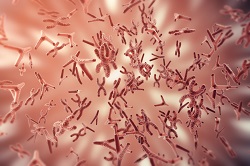A better understanding of gene expression
‘We already know that the different cells in our body share a common DNA sequence and that tissues can be distinguished from one another by the subset of genes that are turned on and off,’ explains Daphne Cabianca, a researcher with the CHROMO-ANCHORING project. ‘Although this is mainly achieved through the action of transcription factors, it remains an open question whether this is also fine-tuned by epigenetic modifications that alter the access of such factors to DNA sequence.’ The question that Cabianca and her team of set out to answer was whether the spatial positioning of DNA within the nucleus also contributes to appropriately programmed gene expression. ‘I set out to determine what factors mediate the sequestration of chromatin in a silent, inaccessible state at the nuclear periphery in differentiated cells,’ explains Cabianca. ‘My long-term goal is to ask if spatial organisation is important for maintaining differentiated patterns of gene expression and to examine how this changes in response to stress.’ Identifying alternative pathways The most abundant building blocks of chromatin are histones, which form a highly repetitive unit that compacts the DNA fibre. Histones themselves are subject to a large range of chemical modifications that occur both before and while they are bound to DNA. Once modified, histones can regulate both the flexibility of chromatin and the expression of genes. ‘Relying largely on the distribution of such histone modifications, chromatin can be divided into two main classes: euchromatin, which typically includes active genes, and heterochromatin, which corresponds to stably silenced parts of the genome,’ says Cabianca. ‘Across species, these two classes of chromatin have conserved but distinct functions and occupy different locations within the nucleus.’ In the nematode, C. elegans, it was found that the deposition of a specific methylation modifying lysine 9 of histone H3 (H3K9me) is an essential signal for the spatial segregation of heterochromatin at the nuclear envelope, the double membrane that surrounds the nucleus. This modification is also recognised by proteins that render chromatin transcriptionally silent, that is, heterochromatic. Thus, sequestration at the nuclear periphery and an absence of transcriptional activity were coordinated by the H3K9 histone modification in early stages of development. However, upon differentiation of embryonic cells into distinct tissues, Cabianca observed that worms that lack the H3K9me signal still show heterochromatin segregation at the nuclear envelope, like wild-type worms. This suggested that another pathway that does not need the K9-methylation signal was active and could retain heterochromatin at the nuclear periphery in differentiated tissues. It was possible that the second pathway acted redundantly, such that the two pathways would reinforce each other, or that the alternative pathway completely replaced the H3K9-methylation pathway to promote the segregation of euchromatin from heterochromatin in differentiated cells. ‘Discovering the proteins involved in this segregation mechanism in the nuclei of intestinal cells became the aim of my research,’ says Cabianca. Discovering the MRG-1 protein By performing a screen with proteins that were likely to recognise histone modifications, researchers discovered a protein called MRG-1, whose loss ablated the clear separation of heterochromatin from euchromatin in intestine cells. This protein is conserved across species from yeast to man, and has been shown to bind histones that carry the methylation mark on another lysine of histone H3, H3K36. In its absence, heterochromatin and euchromatin both became randomly distributed – the active chromatin was no longer exclusively in the nuclear interior and the inactive chromatin no longer placed at the periphery. ‘Such a strong effect, however, only occurred if we also removed H3K9 methylation, confirming that there are two redundant pathways for the separation of chromatin in differentiated cells and not one in tissues that replaces the mechanism that works in embryos,’ explains Cabianca. Unlike H3K9 methylation, the newly identified players in the spatial organisation of chromatin are not part of heterochromatin, but are instead euchromatic factors. ‘Our results indicate that the components of this second pathway act indirectly to antagonise heterochromatin attachment at the nuclear periphery’ adds Cabianca. A new hypothesis Researchers found that this antagonism of spatial separation involves a second highly conserved euchromatic factor, a histone acetyl transferases (HAT). This HAT modifies the same lysine residues in histones that can be methylated, but the acetylation is characteristic of active genes. ‘Our hypothesis for this is that the active mark now “invades” the heterochromatic domain, antagonising the compartmentation that usually keeps order in the nucleus,’ concludes Cabianca. ‘There are thus two sorts of mechanisms that drive the spatial organisation of chromatin in the nucleus: one acts through the positive sequestration of repressive chromatin and the other keeps factors that antagonise the first pathway away from silent domains.’



